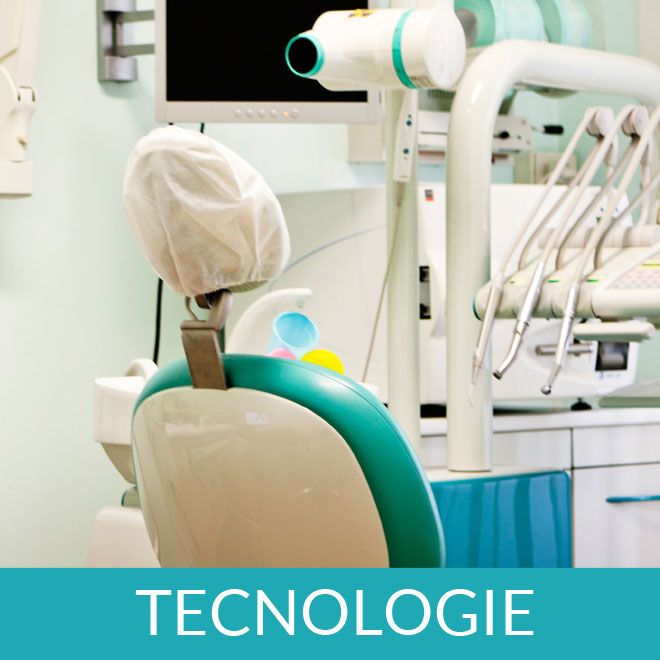Technologies
Technologies
Conscious sedations
 The Oris Dental Center is equipped with Conscious Sedation. This is an analgesia technique that has been widely used in the United States, Canada and several European countries for years. The controlled administration of oxygen and nitrous oxide by inhalation induces a sense of relaxation, thus reducing the emotional load, the perception of pain and the anxiety state. Doing so increases the manageability of the patient, facilitating collaboration with the dentist, while maintaining the reflexes unchanged. It is good to remember that sedation produces no side effects and only presents generic against indications.
The Oris Dental Center is equipped with Conscious Sedation. This is an analgesia technique that has been widely used in the United States, Canada and several European countries for years. The controlled administration of oxygen and nitrous oxide by inhalation induces a sense of relaxation, thus reducing the emotional load, the perception of pain and the anxiety state. Doing so increases the manageability of the patient, facilitating collaboration with the dentist, while maintaining the reflexes unchanged. It is good to remember that sedation produces no side effects and only presents generic against indications.
In Pedodontics: It is known that children are the subjects who suffer most from the problem of “dentist anxiety”, which often leads to the most complete non-cooperation.
The parents of the little patient will be more relaxed because they will see their child more serene, giving the operators the possibility to treat their little one more easily.
For the handicapped: Some categories of handicapped persons, often unable to undergo outpatient dental care, in some cases Sedation radically solves this problem. Alternatively, in the most important and difficult cases, “Deep Sedation” is used with the use of drugs administered by an anesthetist.
In Implantology: This widely used technique “forces” the patient to long intervention times, which produce moments of stress, which sometimes lead to not being cooperative, precisely in the topical moments, sedation helps to face all the phases of the intervention in a serene and collaborative way.
For Dental phobias and other everyday situations: The problem of dental phobias is also widespread in adults and this distances patients from dental care. There are also some stages of dental services, such as taking impressions, ablation of tartar, which often cause unwanted problems. Sedation solves all these problems, bringing the patient closer to the dentist.
Diagnodent caries dedector
 The safe way to safely diagnose and detect caries. In our Center it is possible to carry out a complete check-up to diagnose the most hidden caries to the human eye.
The safe way to safely diagnose and detect caries. In our Center it is possible to carry out a complete check-up to diagnose the most hidden caries to the human eye.
This tool allows you to diagnose in time pathological changes that are very difficult or almost impossible to clinically recognize such as initial lesions, demineralizations and enamel modifications, or cracks, approximal caries or residual caries. The laser emitted by the detector makes use of the different fluorescences emitted by the healthy substance of the tooth compared to the diseased one. The Diagnodent allows an indisputable and early report with a painless and minimally invasive intervention.
Dental scan digital 3D
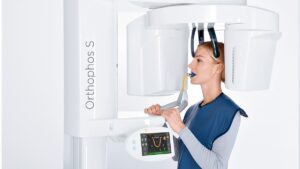
If you wanted to take a selfie of your mouth it would be an orthopanoramic.
Orthopanoramic radiography is one of the main diagnostic tests because:
- allows an overview of the patient’s dental anatomy
- it is the basis on which to set up an accurate therapeutic plan
- allows you to discover possible affections of the stomatognathic system invisible to the physical examination
- it is not invasive for the patient
Given its importance, the Oris Center offers all patients, during the first visit, a free orthopanoramic (on the advice of the dentist and for internal use only).
Computerized archiving offers the possibility of:
- send the DIGITAL ORTHOPANORAMICS FILE via email OR WHATSAPP;
- transfer data on computer media (CD);
- detect and highlight measurements useful in some dental therapies;
- keep images for years without the risk of loss or deterioration.
The images acquired will become an integral part of the patient’s medical records, and will follow their therapeutic path over the years.
to take better care of our patients, we have equipped ourselves with this radiological diagnostic system that provides a digital image of the teeth, of the dental arches directly on a PC to have an immediate possibility of encountering any problems not visible to the naked eye. Our orthopantomograph allows these types of investigations: Orthopanoramic, Bite-wing X-ray, X-ray of the temporomandibular joint, X-ray of the paranasal sinuses, Transverse multi-layering of a lateral tooth, Antero-posterior and lateral teleradiography, Symmetrical carpus X-ray.
Reciproc Endodontic Motor
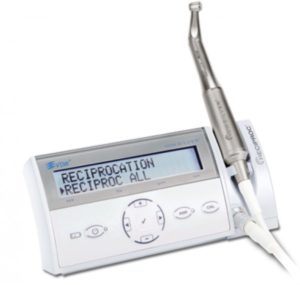 To perform root canal treatments that give excellent results, this important tool is available for the dentist. It gives the possibility to prepare the root canal of a tooth with only one instrument. It has fewer working phases with less risk of fracture of the instruments even in the presence of curved and narrow canals. The instruments are disposable therefore greater safety for the patient.
To perform root canal treatments that give excellent results, this important tool is available for the dentist. It gives the possibility to prepare the root canal of a tooth with only one instrument. It has fewer working phases with less risk of fracture of the instruments even in the presence of curved and narrow canals. The instruments are disposable therefore greater safety for the patient.
Dental Laser
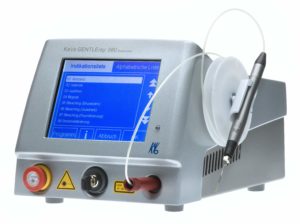 The laser is used in dentistry for molar tissue surgery, it offers an excellent hemostatic and sterilization action. It has a high precision in surgical interventions. Reduced bleeding. Reduced scar formation. Virtually absent postoperative wound pain with no swelling. Decontamination of the irradiated tissue. Effective protection from infections.
The laser is used in dentistry for molar tissue surgery, it offers an excellent hemostatic and sterilization action. It has a high precision in surgical interventions. Reduced bleeding. Reduced scar formation. Virtually absent postoperative wound pain with no swelling. Decontamination of the irradiated tissue. Effective protection from infections.
Intraoral Scanner
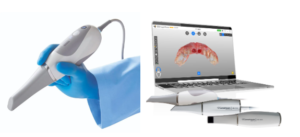 The intraoral scanner, Carestream (CS) 3600, is a 3D scanner capable of detecting dental impressions through the acquisition of a large number of images and then the subsequent reprocessing, using dedicated software.
The intraoral scanner, Carestream (CS) 3600, is a 3D scanner capable of detecting dental impressions through the acquisition of a large number of images and then the subsequent reprocessing, using dedicated software.
The unique continuous scan capabilities of the CS 3600 significantly reduce the time it takes to acquire a scan. Patients spend less time on the unit and the dentist easily acquires all the essential data needed to create the impression in a significantly reduced time.
Amalgam separator
The Oris Dental Center has equipped itself with this tool because it is aware that water is an indispensable resource and it is important not to pollute it. A specific action for drinking water is carried out by this amalgam separator. If amalgam fillings are removed in a practice, the use of the separator is essential to comply with the drainage law. If these particles contained in the wastewater reach the environment, the mercury present in the amalgam, transforming into mercury compounds, becomes toxic: 1 g of mercury is enough to pollute 100,000 liters of drinking water! The law clearly states that waste classified in “CER 180110” must be managed separately and treated as per the specifications listed according to the CER code (European Waste Code) assigned.
The Control of Radiongen Emissions
In addition to caring for the health of its patients, the Oris Dental Center is attentive to safeguarding and respecting the environment.
For this reason, in our Center we have equipped ourselves with cutting-edge technologies and specialized staff able to offer maximum performance with minimum risks for both patients and staff, and for the environment.
Among the most used and effective techniques in the field of dental diagnostics there are certainly radiological techniques that require modern equipment but also constant supervision.
The Oris Center therefore avails itself of the professionalism of an Engineer, a Qualified Expert, who annually certifies the X-ray emissions, to ensure the absence of risks deriving from failures and malfunctions, in full compliance with the legislation.
The sterilization

If for our laundry we take care to use the best products, which in addition to washing disinfect, and to do it at optimal temperatures that give us the certainty of a perfect result.
So why not expect the same treatment for our peace of mind, especially when we are in the medical-health field?
Probably because we believe that the foresight of compliance with hygiene rules is the minimum requirement of any health facility, but unfortunately this is not always the case.
This is why our twenty years of experience in dentistry has led us to identify some strengths to be proud of and for which, on a daily basis, we are chosen and reconfirmed by our patients.
One of these is certainly attention to compliance with hygiene and sterilization standards.
In fact, among the fears that accompany patients in choosing a dentist, there is that of being in contact with instruments that are not perfectly sterilized that can cause very serious infections and diseases such as hepatitis and HIV (AIDS).
For this reason, the oris dental center has always paid the utmost attention to hygiene and sterilization through various measures such as:
- the use of disposable instruments
- the use of a machine for hot disinfection with disinfectant liquid and ultrasonic cleaning that will remove residues of cement, alginate and blood
- the individual wrapping of surgical instruments.
- the final passage in a high pressure autoclave with integrated printing of the success of the sterilization cycle
- the labeling of each sterilized envelope with the expiry date of 30/60 days.
- 8 tests to check and control the various sterilization cycles
For more information on sterilization techniques, a more exhaustive and detailed document is available at our facility
THE INTRAORAL CAMERA

It is said that a picture is worth a thousand words, we at the Oris Center are convinced of that.
Because if it is true that trust in your doctor is important, seeing with your own eyes the starting condition and following the progress of therapy in real time is also essential.
For this reason, the Oris center is equipped with an intraoral camera that allows both the doctor and the patient to observe the oral cavity (or even just a tooth) comfortably from the images transmitted on the monitor located near the work chair.
The image framed by the camera is extremely enlarged in order to highlight any traumatic situations clearly, allowing the patient to see it too, benefiting from a greater understanding of the proposed treatment.
Furthermore, the camera is useful because:
- enlarges and illuminates the operating field;
- facilitates the execution of certain operations;
- allows the archiving of precise images;
- helps to monitor the evolution of the clinical condition of patients;
- shows the correct execution of the interventions at the end of the therapy.
VIDEO RADIOGRAPHY
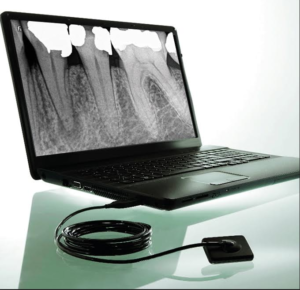
Once in order to see a photograph it was necessary to go to the photographer and wait for the technical development and printing times, but now this is no longer the case because thanks to digital everything we shoot, through a camera or the lens of a mobile phone, arrives directly. on our screens.
Something like this has also happened in the field of diagnostic tests, in fact, if traditional radiography was more like an analogue photograph, with film and development, videoradiography is more like a video shot made with a sophisticated high-resolution digital camera.
Videoradiography (RVG) is a step up from traditional radiography, enabling first-class diagnostic and operational examinations through the KODAK System.
The KODAK system uses an intraoral sensor that allows you to obtain very detailed digital images in real time directly on the PC monitor and reducing the emission of radiation by 80% compared to those required for traditional plates
Among the advantages of the RVG:
- the immediacy of viewing the result
- the very low emission of X-rays compared to traditional radiography
the high possibilities of USING the image (which allow you to rotate, enlarge, intensify, and send via email OR WHATSAPP).
